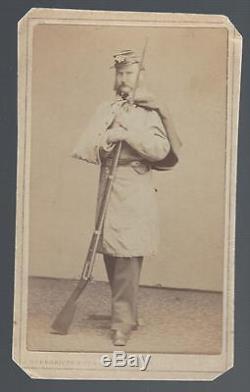Civil War Era CDV Colonel Charles Graham Halpine 69th NYVI Irish Brigade



Charles Graham Halpine was born in Oldcastle, co. Meath, Ireland to Reverend Nicholas John Halpin and Anne Grehan.
Although originally educated for the medical and law professions at Trinity College in Dublin, the early death of his father caused Halpine to take up journalism. Immigrating to the United States in 1851 (Boarse), he initially supported himself by working in advertising and later as the private secretary to P. He would later become a well-known poet and journalist most recognized under the name Miles OReilly. Halpines earliest writing appeared in the Carpet Bag, a humorous magazine which he started with Benjamin P.
Shillaber, and also became assistant editor of the Boston Post. He became a French translator for the New York Herald in 1853 (Derby). In he anonymously compiled a collection of his previously published works, but the collection was not met with a great deal of critical approval (Monoghan). Halpine next worked as a correspondent, and eventual associate editor, for the New York Times where he eventually became an associate editor.In 1857, he assumed the job of editor for the Leader and under his guidance the magazine saw an increase in popularity and importance. While maintaining his job as editor, Halpine also published numerous articles and poems. Monoghan explains that his contributions to magazines and newspapers were clever and voluminous and brought him a large income.
Halpine also edited the New York Ledger, a Democratic weekly paper (Lause). Mentioned as one of the bright spirits who met at Pfaffs in a Charles Pfaff obituary (In and about the City), Halpine was a well-known and much admired presence in the literary scene (Winter 61). Multiple sources place him at Pfaffs, as he is identified as one of the others who rallied at Pfaffs (Maurice 396) and as one of the Knights of the Round Table of the lions of Bohemia (In and about the City). Derby mentions him as brightest and most popular humorous men of the day (239).He also describes a letter of introduction from Shillaber which stated that the bearer was not only a brilliant writer on any subject, but a born poet and a real genius in wit and humor (426). A brilliant conversationalist, Halpine stammered to fame at Pfaffs, speaking inadvertently of H-H-Harriet Beseecher Bestowe (Starr 9). Much of Halpines work grew out of his experiences during the Civil War.
When the fighting began in April 1861, he enlisted in the 69th New York Infantry and was soon promoted to lieutenant. He was then transferred to work under General David Hunter as assistant adjutant-general with the rank of major (Boarse). He was repeatedly promoted for gallantry and distinguished services until he reached the rank of brigadier-general (Monoghan).
After his military experience, Halpine "resigned, and lived to make his name famous by his humorous sketches of army life supposed to have been penned by'Private Miles O'Reilly,'" which were published in Northern periodicals (Hemstreet 220). His Sambos Right to be Kilt was useful in calming white soldiers objections to the enlistment of black soldiers for a new regiment. He retired from the army in 1864 due to his deteriorating eyesight. According to Gunn in 1862, he had a wife and children in New York or Washington (20.56).
Halpine had long showed interest in politics, becoming a member of the Young Ireland group in Dublin and serving as private secretary to American politician Steven A. In 1866, Halpine was elected Register of the County and City of New York, beating the candidate from Tammany Hall with a majority of 20,000 votes. Gunn annotates a related news clipping with, As editor of the Citizen, General Halpine has rendered important support to the Conservative party in America by his popularity and active political service (20.189). He published Miles OReilly His Book in 1864 and Baked Meats of the Funeral in 1866. Halpine died suddenly from an accidental overdose of chloroform in 1868.While Gunn suggests that his death may have been suicide (20.189), J. Derby explains that had taken the draught to soothe a migraine. Derby writes, Thus, by a mere accident, a most important life was taken away from this public and at its period of greatest usefulness.
He died ere more than half his natural term of activity had run, at the age of thirty-nine, at a period when his faculties were in their most perfect development (430). Civil War Union Brevet Brigadier General. Born in Ireland, he emigrated to the United States in 1851, working as a journalist and newspaper editor. When the Civil War began he was commissioned as a 1st Lieutenant in the 69th New York Militia, a pre-war unit that had it's ranks filled with many Irish expatriates. After being discharged after a three month enlistment, he received a commission of Major, Assistant Adjutant General, US Volunteers on September 5, 1861, and was assigned to the staff of Major General John A.In 1862 he started writing humorous articles, stories and poems of Army life under the pseudonym "Miles O' Riley", which were published in a number of newspapers and became very to both soldiers and civilians. Transferred to the staff of Major General David Hunter, he was promoted to Lieutenant Colonel, and served until poor eyesight caused his disability discharge on July 31, 1864. He was brevetted Brigadier General, US Volunteers on March 13, 1865 for "meritorious services during the war". The item "Civil War Era CDV Colonel Charles Graham Halpine 69th NYVI Irish Brigade" is in sale since Tuesday, August 01, 2017. This item is in the category "Collectibles\Militaria\Civil War (1861-65)\Original Period Items\Photographs".
The seller is "civil_war_photos" and is located in Midland, Michigan. This item can be shipped worldwide.
- Country/Region of Manufacture: United States

